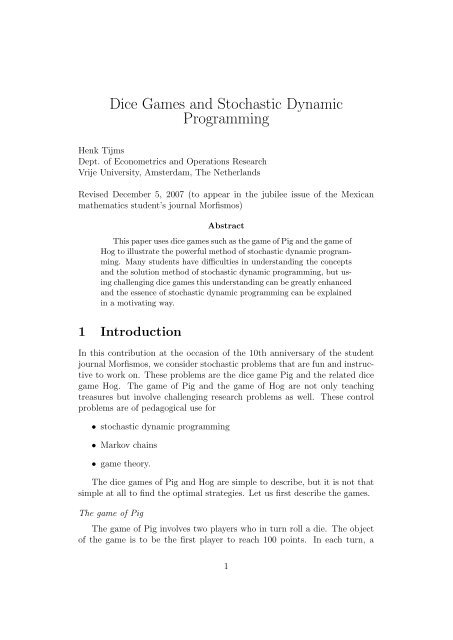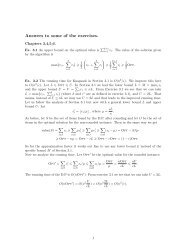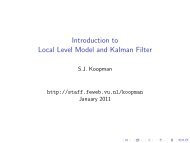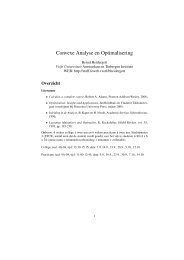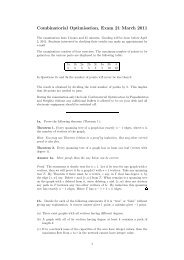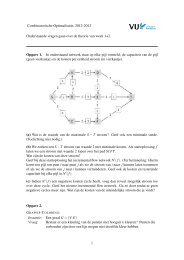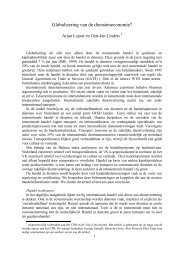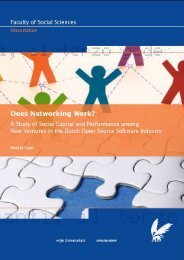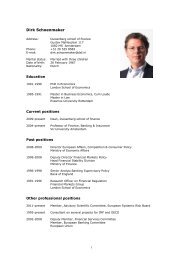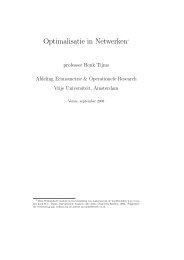Dice Games and Stochastic Dynamic Programming
Dice Games and Stochastic Dynamic Programming
Dice Games and Stochastic Dynamic Programming
You also want an ePaper? Increase the reach of your titles
YUMPU automatically turns print PDFs into web optimized ePapers that Google loves.
<strong>Dice</strong> <strong>Games</strong> <strong>and</strong> <strong>Stochastic</strong> <strong>Dynamic</strong><br />
<strong>Programming</strong><br />
Henk Tijms<br />
Dept. of Econometrics <strong>and</strong> Operations Research<br />
Vrije University, Amsterdam, The Netherl<strong>and</strong>s<br />
Revised December 5, 2007 (to appear in the jubilee issue of the Mexican<br />
mathematics student’s journal Morfismos)<br />
Abstract<br />
This paper uses dice games such as the game of Pig <strong>and</strong> the game of<br />
Hog to illustrate the powerful method of stochastic dynamic programming.<br />
Many students have difficulties in underst<strong>and</strong>ing the concepts<br />
<strong>and</strong> the solution method of stochastic dynamic programming, but using<br />
challenging dice games this underst<strong>and</strong>ing can be greatly enhanced<br />
<strong>and</strong> the essence of stochastic dynamic programming can be explained<br />
in a motivating way.<br />
1 Introduction<br />
In this contribution at the occasion of the 10th anniversary of the student<br />
journal Morfismos, we consider stochastic problems that are fun <strong>and</strong> instructive<br />
to work on. These problems are the dice game Pig <strong>and</strong> the related dice<br />
game Hog. The game of Pig <strong>and</strong> the game of Hog are not only teaching<br />
treasures but involve challenging research problems as well. These control<br />
problems are of pedagogical use for<br />
• stochastic dynamic programming<br />
• Markov chains<br />
• game theory.<br />
The dice games of Pig <strong>and</strong> Hog are simple to describe, but it is not that<br />
simple at all to find the optimal strategies. Let us first describe the games.<br />
The game of Pig<br />
The game of Pig involves two players who in turn roll a die. The object<br />
of the game is to be the first player to reach 100 points. In each turn, a<br />
1
player repeatedly rolls a die until either a 1 is rolled or the player holds. If<br />
the player rolls a 1, the player gets a score zero for that turn <strong>and</strong> it becomes<br />
the opponent’s turn. If the player holds after having rolled a number other<br />
than 1, the total number of points rolled in that turn is added to the player’s<br />
total score <strong>and</strong> it becomes the opponent’s turn. At any time during a player’s<br />
turn, the player must choose between the two decisions “roll” or “hold”.<br />
The game of Hog<br />
The game of Hog (fast Pig) is a variation of the game of Pig in which<br />
players have only one roll per turn but may roll as many dice as desired.<br />
The number of dice a player chooses to roll can vary from turn to turn. The<br />
player’s score for a turn is zero if one or more of the dice come up with the<br />
face value 1. Otherwise, the sum of the face values showing on the dice is<br />
added to the player’s score.<br />
We will first analyze the single-player versions of the two stochastic control<br />
problems. For various optimality criteria in the single player problem,<br />
the stochastic dynamic programming approach for calculating an optimal<br />
control rule will be discussed. The optimal control rule is rather complex<br />
<strong>and</strong> therefore its performance will also be compared with the performance of<br />
a simple heuristic rule.<br />
2 The game of Pig<br />
We first consider the single-player version of the game of Pig before we discuss<br />
the dynamic programming approach the case with two players. In the twoplayer’s<br />
case the goal is to be the first player reaching 100 points. For the<br />
single-player version the following two optimality criteria can be considered:<br />
• minimal expected number of turns to reach 100 points<br />
• maximal probability of reaching 100 points in a given number of turns.<br />
The optimal control rules can be calculated from the optimality equations<br />
from stochastic dynamic programming, but these optimal rules are rather<br />
complex <strong>and</strong> difficult to use in practice. Therefore we also consider the<br />
simple “hold at 20” heuristic <strong>and</strong> compare the performance of this heuristic<br />
with the performance of the optimal rule. The “hold at 20” rule is as follows:<br />
after rolling a number other than 1 in the current turn, the player holds that<br />
turn when the accumulated number of points during the turn is 20 or more.<br />
The rationale of this simple heuristic is easily explained. Suppose that k<br />
points have been accumulated so far in the current turn. If you roll again,<br />
2
the expected number of points you gamble away is 1 × k, while the expected<br />
6<br />
number of additional points you gain is equal to 5 × 4, using the fact the<br />
6<br />
expected value of the outcome of a roll of a die is 4 given that the outcome<br />
is not 1. The first value of k for which 1 5 × k ≥ × 4 is k = 20.<br />
6 6<br />
It turns out that the “hold at 20” heuristic performs very well the criterion<br />
is to minimize the expected number of turns to reach 100 points. As will be<br />
shown below, the expected value of the number of turns to reach 100 point is<br />
12.545 when the “hold at 20” heuristic is used <strong>and</strong> this lies only 0.7% above<br />
the minimal expected value 12.367 that results when an optimal control rule is<br />
used. The situation is different for the criterion of maximizing the probability<br />
of reaching 100 points within a given number of turns. Under the “hold at<br />
20” heuristic the probability of reaching 100 points within N turns has the<br />
respective values 0.0102, 0.0949, 0.3597, 0.7714, <strong>and</strong> 0.9429 for N =5, 7, 10,<br />
15, <strong>and</strong> 20, whereas this probability has the maximum values 0.1038, 0.2198,<br />
0.4654, 0.8322, <strong>and</strong> 0.9728 when an optimal rule is used. Thus, the “hold at<br />
20” heuristic performs unsatisfactorily for the second optimality criterion.<br />
Analysis of the heuristic rule<br />
The analysis for the “hold at 20” heuristic is based on recurrence relations<br />
that are derived by arguments used to analyze absorbing Markov chains<br />
(alternatively, the heuristic can be be analysed by a slight modification of the<br />
dynamic-programming analysis for an optimal rule in the next paragraph).<br />
Define µi as the expected value of the number of turns needed to reach a total<br />
score of 100 points when starting a new turn with a score of i points <strong>and</strong> using<br />
the “hold at 20” rule. The goal is to find µ0. For a=0, 20, 21, 22, 23, 24, <strong>and</strong><br />
25, denote by α0,a the probability that the player will end up with exactly a<br />
points in any given turn under the “hold at 20” rule. Once the probabilities<br />
α0,a have been computed, we calculate the µi by a backwards recursion. By<br />
the law of conditional expectations,<br />
µi = 1 + µiα0,0 +<br />
25<br />
a=20<br />
µi+aα0,a<br />
for i = 99, 98 . . . , 0.<br />
with the convention µk = 0 for k ≥ 100. Thus, initiating the recursion with<br />
µ99 = 1 + µ99α0,0, we compute successively µ99, µ98, . . . , µ0. How to calculate<br />
the probabilities α0,a? This goes along the same lines as the computation of<br />
the absorption probabilities in a Markov chain with absorbing states. For any<br />
fixed a, we use the intermediary probabilities αb,a for 0 ≤ b ≤ 19, where αb,a<br />
is defined as the probability that the current turn will end up with exactly a<br />
points when so far b points have been accumulated during the current turn<br />
3
<strong>and</strong> the “hold at 20 rule” is used. For a = 0, we find by the law of conditional<br />
probabilities that<br />
αb,0 = 1<br />
6 +<br />
6<br />
j=2<br />
1<br />
αb+j,0<br />
6<br />
for b = 19, 18, . . . , 0<br />
with the convention αk,0 = 0 for k ≥ 20. For any a with 20 ≤ a ≤ 25, we<br />
find by conditioning that<br />
αb,a =<br />
6<br />
j=2<br />
1<br />
αb+j,a<br />
6<br />
for b = 19, 18, . . . , 0<br />
with the convention αk,a = 1 for k = a <strong>and</strong> αk,a = 0 for k ≥ 20 <strong>and</strong> k = a.<br />
Applying these recursion equations, we find α0,0 = 0.6245, α0,20 = 0.0997,<br />
α0,21 = 0.0950, α0,22 = 0.0742, α0,23 = 0.0542, α0,24 = 0.0352, <strong>and</strong> α0,25 =<br />
0.0172. Next the value µ100 = 12.637 is calculated for the expected number<br />
of turns needed to reach 100 points if the “hold at 20 rule” is used.<br />
How do we calculate the probability of reaching 100 points in no more<br />
than N turns under the “hold at 20” heuristic? To do so, we define Qn(i) for<br />
i < 100 <strong>and</strong> n ≥ 1 the probability Qn(i) as the probability of reaching 100<br />
points in no more than n turns when the first turn is started with a score<br />
of i points <strong>and</strong> the “hold at 20 rule” is used . Also, let Qn(i) = 1 for any<br />
i ≥ 100 <strong>and</strong> n ≥ 1. If no more than a given number of N turns are allowed,<br />
the desired probability is QN(0). Using the law of conditional probabilities,<br />
it follows that the probabilities Qn(i) for n = 1, 2, . . . can be computed from<br />
the recursion<br />
Qn(i) = Qn−1(i)α0,0 +<br />
25<br />
a=20<br />
Qn−1(i + a)α0,a<br />
for i < 100 <strong>and</strong> n ≥ 1 with the boundary condition Q0(j) = 1 for j ≥ 100<br />
<strong>and</strong> Q0(j) = 0 for j < 100.<br />
<strong>Dynamic</strong> programming for the single-player version<br />
In the optimality analysis of the single-player version, a state variable<br />
should be defined together with a value function. The state s of the system<br />
is defined by a pair s = (i, k), where<br />
i = the player’s score at the start of the current turn<br />
k = the number of points obtained so far in the current turn.<br />
4
We first the criterion of minimizing the expected number of turns to reach<br />
100 points. For this criterion, the value function V (s) is defined by<br />
V (s) = the minimal expected value of the number of turns including<br />
the current turn to reach 100 points starting from state s.<br />
We wish to compute V (0, 0) together with the optimal decision rule. This<br />
can be done from Bellman’s optimality equations. For k = 0,<br />
For k ≥ 1 <strong>and</strong> i + k < 100,<br />
V (i, 0) = 1 + 1<br />
V (i, 0) +<br />
6<br />
V (i, k) = min[V (i + k, 0), 1<br />
V (i, 0) +<br />
6<br />
6<br />
r=2<br />
1<br />
V (i, r).<br />
6<br />
6<br />
r=2<br />
1<br />
V (i, k + r)],<br />
6<br />
where V (i, k) = 0 for those (i, k) with i + k ≥ 100. The first term in the<br />
right side of the last equation corresponds to the decision “hold” <strong>and</strong> the<br />
second term corresponds to the decision “roll”. The optimality equation can<br />
be solved by the method of successive substitutions. Starting with V0(s) = 0<br />
for all s, the functions V1(s), V2(s), . . . are recursively computed from<br />
<strong>and</strong><br />
Vn(i, 0) = 1 + 1<br />
6 Vn−1(i, 0) +<br />
6<br />
r=2<br />
Vn(i, k) = min[Vn−1(i + k, 0), 1<br />
V (i, 0) +<br />
6<br />
1<br />
6 Vn−1(i, r), n = 1, 2, . . .<br />
6<br />
r=2<br />
1<br />
6 Vn−1(i, k + r)], n = 1, 2, . . . .<br />
By a basic result from the theory of stochastic dynamic programming,<br />
lim<br />
n→∞ Vn(s) = V (s) for all s.<br />
In the literature bounds are known for the difference |Vn(s)−V (s)|, providing<br />
a stopping criterion for the method of successive substitutions.<br />
Let us next consider the optimality criterion of maximizing the probability<br />
of reaching 100 points in no more than N turns with N a given integer. Then,<br />
we define for m = 0, 1, . . . , N the value function Pm(s) by<br />
Pm(s) = the maximal probability of reaching 100 points from state s if<br />
no more than m turns can be used including the current turn,<br />
5
where Pm(s) = 1 for all s = (i, k) with i + k ≥ 100. The desired probability<br />
PN(0, 0) <strong>and</strong> the optimal decision rule can be calculated from Bellman’s<br />
optimality equation. For k = 0 <strong>and</strong> i = 99, 98, . . . , 0<br />
Pm(i, 0) = 1<br />
6 Pm−1(i, 0) +<br />
6<br />
r=2<br />
1<br />
6 Pm(i, r), m = 1, . . . , N<br />
<strong>and</strong> for i = 98, 97, . . . , 0 <strong>and</strong> k = 99 − i, . . . , 1<br />
Pm(i, k) = min[Pm−1(i + k, 0), 1<br />
6 Pm−1(i,<br />
6 1<br />
0) +<br />
6 Pm(i, k + r)], 1 ≤ m ≤ N.<br />
The value functions P1(s), P2(s), . . . , PN(s) can be recursively calculated, using<br />
the fact that Pm(i, k) = 1 if i + k ≥ 100 <strong>and</strong> starting with<br />
<br />
1 if i + k ≥ 100<br />
P0(i, k) =<br />
0 if i + k < 100.<br />
r=2<br />
<strong>Dynamic</strong> programming for the two-players case<br />
To conclude this section, we consider for the game of Pig the case of two<br />
players. The players alternate in taking turns rolling the die. The first player<br />
to reach 100 points is the winner. Since there is an advantage in going first<br />
in Pig, it is assumed that a toss of a fair coin decides which player begins in<br />
the game of Pig. Then, under optimal play of both players, each player has<br />
a probability of 50% of being the ultimate winner. But how to calculate the<br />
optimal decision rule. By the assumption that players alternate in taking<br />
turns rolling the die, the optimal decision rule can be computed by using<br />
st<strong>and</strong>ard dynamic programming techniques. In the final section of this paper<br />
we will consider a variant of the game of Hog in which in each round the<br />
two players have to decide simultaneously how many dice to roll, where the<br />
players cannot observe each other’s decision. Such a variant with simultaneous<br />
actions of both players in the same turn can also be considered for the<br />
game of Pig. Then, methods from st<strong>and</strong>ard dynamic programming cannot<br />
be longer used but instead one should use much more involved methods from<br />
game theory.<br />
The dynamic programming solution for the game of Pig with two players<br />
who alternate in taking turns proceeds as follows. The state s is defined by<br />
s = ((i, k), j), where (i, k) indicates that the player whose turn it is has a<br />
score i <strong>and</strong> has k points accumulated so far in the current turn <strong>and</strong> j indicates<br />
that the opponent’s score is j. Define the value function P (s) by<br />
P (s) = the probability of the player winning whose turn it is<br />
given that the present state is state s,<br />
6
where P (s) is taken to be equal to 1 for those s = ((i, k), j) with i + k ≥ 100<br />
<strong>and</strong> j < 100. To write down the optimality equations, we use the simple<br />
observation that the probability of a player winning after rolling a 1 or holding<br />
is one minus the probability that the other player will win beginning with<br />
the next turn. Thus, for state s = ((i, k), j) with k = 0,<br />
P ((i, 0), j) = 1<br />
[1 − P ((j, 0), i)] +<br />
6<br />
6<br />
r=2<br />
For state s = ((i, k), j) with k ≥ 1 <strong>and</strong> i + k, j < 100,<br />
P ((i, k), j)) = min[1−P ((j, 0), i+k), 1<br />
[1−P ((j, 0), i)]+<br />
6<br />
1<br />
P ((i, r), j).<br />
6<br />
6<br />
r=2<br />
1<br />
P ((i, k+r), j)],<br />
6<br />
where the first expression in the right side of the last equation corresponds<br />
to the decision “hold” <strong>and</strong> the second expression corresponds to the decision<br />
“roll”. Using the method of successive substitution, these optimality equations<br />
can be numerically solved, yielding the optimal decision to take in any<br />
state s = ((i, k), j).<br />
3 The game of Hog<br />
We first give the analysis for the single-player version of the game. In the<br />
game of Hog (Fast Pig) the player has to decide in each turn how many dice<br />
to roll simultaneously. A similar heuristic as the “hold at 20” rule manifests<br />
itself in the game of Hog (Fast Pig). This heuristic is the “five dice” rule that<br />
prescribe to roll five dice in each turn. The rationale of this rule is as follows:<br />
five dice are the optimal number of dice to roll when the goal is to maximize<br />
the expected value of the score in a single turn. The expected value of the<br />
total score in a single turn with d dice is (1 − (5/6) d ) × 0 + (5/6) 5 × 4d <strong>and</strong><br />
this expression is maximal for d = 5. The number of turns needed to reach<br />
100 points has the expected value 13.623 when the “five dice” rule is used,<br />
while the expected value of the number of turns needed to reach 100 points<br />
has the value 13.039 when an optimal decision rule is used. Again, a very<br />
good performance of the heuristic rule when the criterion is to minimize the<br />
expected number of turns. However, the story is different when the criterion<br />
is to maximize the probability of reaching 100 points in no more than N<br />
turns with N given. This probability has the respective values 0.0056, 0.0610,<br />
0.2759, 0.6993, <strong>and</strong> 0.9159 for N=5, 7, 10, 15, <strong>and</strong> 20 when the “five dice”<br />
rule is used, while the respective values are 0.0869, 0.1914, 0.4240, 0.8004,<br />
<strong>and</strong> 0.9631 under an optimal rule.<br />
7
Analysis for the single-player version<br />
For both the criterion of the expected number of turns to reach 100 points<br />
<strong>and</strong> the criterion of the probability to reach 100 points in a given number<br />
of turns, we will give a unified analysis that covers both the heuristic rule<br />
<strong>and</strong> the optimal rule. Instead of taking the state as the current score of<br />
the player, it is convenient to define the state as the number of points the<br />
player still needs to reach the goal when a new turn is about to begin. The<br />
decision d in any state s prescribes to roll simultaneously d dice. Denoting<br />
the set of possible decisions in state s by D(s), we can give a unified analysis<br />
by taking D(s) = {5} for the analysis of the “five dice” rule <strong>and</strong> taking<br />
D(s) = {1, 2, . . . , D} for the analysis of an optimal rule, where D is finite<br />
but large number. A key ingredient in the computations are the probabilities<br />
to be defined by<br />
q (d)<br />
i<br />
q (d)<br />
i = the probability of obtaining i points in a turn<br />
when the decision is to roll d dice.<br />
To calculate these probabilities, we need the probability r (d)<br />
i<br />
which is defined<br />
as the conditional probability that a roll of d dice gives i points given that no<br />
1s are rolled. Using the fact that the conditional distribution of the outcome<br />
of the roll of a single die is uniformly distributed on the integers 2, . . . , 6<br />
given that the outcome is not 1, it follows that the r (d)<br />
i can be recursively<br />
calculated from the convolution formula<br />
r (d)<br />
i<br />
=<br />
6<br />
j=2<br />
1<br />
5 r(d−1) i−j for i = 2d, 2d + 1, . . . , 6d, <strong>and</strong> r (d)<br />
i = 0 otherwise,<br />
with the convention r (0)<br />
0 = 1 <strong>and</strong> r (0)<br />
i<br />
q (d)<br />
0 = 1 −<br />
d 5<br />
6<br />
<strong>and</strong> q (d)<br />
i<br />
= 0 for i = 0. Next, the q(d) i follow from<br />
=<br />
d 5<br />
r<br />
6<br />
(d)<br />
i<br />
for i, d = 1, 2, . . . .<br />
For the criterion of the expected number of turns to reach the goal, we<br />
define the value-function V (i) as the minimal expected number of additional<br />
turns to get i additional points when using the decision sets D(i) (in case<br />
D(i) = {5} for all i, the minimal expected number should of course be read<br />
as the expected number). The goal is to calculate V (100). Then, letting<br />
V (i) = 0 for i ≤ 0, we have the dynamic programming equation:<br />
<br />
<br />
V (i) = min<br />
d∈D(i)<br />
1 + q (d)<br />
0 V (i) +<br />
8<br />
6d<br />
r=2d<br />
q (d)<br />
r V (i − r)
or, equivalently,<br />
V (i) = min<br />
d∈D(i)<br />
<br />
1<br />
1 − q (d)<br />
0<br />
<br />
1 +<br />
6d<br />
r=2d<br />
q (d)<br />
r V (i − r)<br />
<br />
The function values V (i) can be computed recursively for i = 1, 2, . . . , 100.<br />
For the criterion of the probability of reaching the goal within a given<br />
number of N turns, the value function Pm(i) is defined as the maximal probability<br />
to get i additional points when no more than m turns are allowed,<br />
where m runs from 1 to N. We wish to find PN(100). Letting Pm(i) = 1 for<br />
i ≤ 0, we have the dynamic programming equation:<br />
<br />
<br />
Pm(i) = min<br />
d∈D(i)<br />
q (d)<br />
0 Pm−1(i) +<br />
6d<br />
r=2d<br />
q (d)<br />
r Pm−1(i − r)<br />
The recursion is initiated with P0(i) = 1 for i ≤ 0 <strong>and</strong> P0(i) = 0 for i > 0.<br />
Analysis for the case of two players<br />
To conclude this section, we consider for the game of Hog the original case<br />
of two players. The players alternate in taking turns rolling the die. The<br />
first player to reach 100 points is the winner. Since there is an advantage in<br />
going first in Hog, it is assumed that a toss of a fair coin decides which player<br />
begins in the game of Hog. The dynamic programming solution for the game<br />
of Hog with two players who alternate in taking turns proceeds as follows.<br />
The state defined as s = (i, j), where i indicates the number of points the<br />
player whose turn it is still needs for the winning score <strong>and</strong> j indicates the<br />
number of points the opponent still needs for the winning score. Define the<br />
value function P (s) as the win probability of the player whose turn it is given<br />
that the present state is state s <strong>and</strong> both players act optimally in each turn.<br />
Then, for the states (i, j) with i, j > 0, the optimality equation is<br />
<br />
<br />
P (i, j) = max<br />
d=1,...,D<br />
q (d)<br />
0 [1 − P (j, i)] +<br />
6d<br />
r=2d<br />
q (d)<br />
r [1 − P (j, i − r)]<br />
with the convention P (j, k) = 0 for j > 0 <strong>and</strong> k ≤ 0, where D denotes the<br />
largest number of dice that can be rolled.<br />
4 A game-theoretic problem<br />
This section considers a variant of the game of Hog, where the two players<br />
have to take simultaneously a decision in each round of the game. At the<br />
9<br />
.<br />
.<br />
,
end of the television game show two remaining contestants each sit behind<br />
a panel with a battery of buttons numbered as 1, 2, . . . , D, say D=10. In<br />
each stage of the game, both contestants must simultaneously press one of<br />
the buttons, where the contestants cannot observe each other’s decision. The<br />
number on the button pressed by the contestant is the number of dice that<br />
are thrown for the contestant. For each contestant the score of the throw<br />
for that contestant is added to his/her total, provided that none of the dice<br />
in that throw showed the outcome 1; otherwise no points are added to the<br />
current total of the c<strong>and</strong>idate. The c<strong>and</strong>idate who first reaches a total of 100<br />
points is the winner. In case both c<strong>and</strong>idates reach the goal of 100 points<br />
in the same move, the winner is the c<strong>and</strong>idate who has the largest total. In<br />
the event of a tie, the winner is determined by a toss of a fair coin. At each<br />
stage of the game both c<strong>and</strong>idates have full information about his/her own<br />
current total <strong>and</strong> the current total of the opponent. What does the optimal<br />
strategy look like?<br />
The computation <strong>and</strong> the structure of an optimal strategy is far more<br />
complicated than in the problems discussed before. The optimal rules for<br />
the decision problems considered before were deterministic, but the optimal<br />
strategy will involve r<strong>and</strong>omized actions for the problem of the television<br />
game show. In zero-sum games r<strong>and</strong>omization is a key ingredient of the<br />
optimal strategy.<br />
We will give only an outline of the solution procedure. The rules of the<br />
game state that in each round the two players have to decide at the same<br />
moment upon the number of dice to use, so without seeing what the opponent<br />
is doing but knowing <strong>and</strong> using the scores so far. So, after a number of rounds<br />
player 1 still needs a points <strong>and</strong> player 2 needs b points. This describes the<br />
state of the system. If now player 1 decides to use k dice <strong>and</strong> player 2<br />
decides to use l dice, then the state changes from (a, b) into (a − i, b − j) with<br />
probability q (k)<br />
i q(l) j . The game is a stochastic terminating zero-sum game.<br />
The value of the game is defined as the probability that player 1 will win<br />
minus the probability that player 2 will win, given that both players play<br />
optimally. Define<br />
⎧<br />
⎨ 1 if a < b <strong>and</strong> a ≤ 0<br />
V (a, b) = 0 if a = b ≤ 0<br />
⎩<br />
−1 if a > b <strong>and</strong> b ≤ 0.<br />
We want to determine V (a, b) for both a <strong>and</strong> b positive <strong>and</strong> the optimal,<br />
possibly r<strong>and</strong>omized, actions that guarantee this value. The value of the<br />
game <strong>and</strong> the optimal moves of the two players can be computed by repeatedly<br />
solving the appropriate matrix games. Let x = (x1, x2, . . . , xD) be<br />
a r<strong>and</strong>omized move for player 1, i.e., player 1 rolls d dice with probability<br />
10
xd,where <br />
d xd = 1. The first approach to think off is to recursively compute<br />
V (a, b) via a sequence of LP -problems, starting in (a, b) = (1, 1) <strong>and</strong> working<br />
backwards, step by step, until (a, b) = (G, G) with G = 100. This requires<br />
to solve the optimization problem:<br />
<br />
d<br />
xd<br />
<br />
i+j>0<br />
q (d)<br />
maximize V subject to<br />
<br />
i q(l) j V (a − i, b − j) + q(d) 0 q (l)<br />
0 V<br />
≥ V, l = 1, . . . , D,<br />
xd ≥ 0, d = 1, . . . , D, <br />
xd = 1, V unrestricted in sign ,<br />
d<br />
where, for i + j > 0, the values V (a − i, b − j) have been computed before<br />
<strong>and</strong> hence are known. However, this optimization problem is not exactly an<br />
LP -problem because of the nonlinear term (d)<br />
d xdq 0 q (l)<br />
0 V .<br />
To make an LP -approach possible, we proceed as follows. Define V (n) (a, b)<br />
as the value of the game if it is played at most n times with a terminal reward<br />
0, if after n steps the game has not yet reached the payoff-zone. Thus,<br />
V (0) (a, b) := 0 if a > 0 <strong>and</strong> b > 0. Also, define<br />
V (n) (a, x, b, l) = <br />
d<br />
xd<br />
<br />
i,j<br />
q (d)<br />
i q(l)<br />
j V (n−1) (a − i, b − j), n > 0 ,<br />
with the convention that, for n ≥ 0 <strong>and</strong> a ≤ 0 or b ≤ 0, V (n) (a, b) = V (a, b).<br />
Then, in iteration n for state (a, b), the value of the game <strong>and</strong> an optimal<br />
move for player 1 can be obtained from an LP -problem for a matrix game:<br />
maximize V subject to<br />
V (n) (a, x, b, l) ≥ V, l = 1, . . . , D,<br />
xd ≥ 0, d = 1, . . . , D, <br />
xd = 1, V unrestricted in sign.<br />
d<br />
The optimal value V satisfies V = V (n) (a, b) <strong>and</strong> the optimal x (n) (a, b) represents<br />
an optimal move for player 1 in state (a, b) in iteration n. V (n) (a, x, b, l)<br />
converges exponentially fast to the value of the game, <strong>and</strong> x (n) is nearly optimal<br />
for n sufficiently large. Of course, for reasons of symmetry, the optimal<br />
move for player 2 in state (a, b) is the same as the optimal move for player<br />
1 in state (b, a). The computations for an optimal strategy are formidable<br />
for larger values of D with D being the maximum number of dice that can<br />
be rolled. The computations reveal that the optimal strategy uses indeed<br />
r<strong>and</strong>omized actions. For example, for the case of D = 5, player 1 uses 2,<br />
11
4 or 5 dice with respective probabilities 0.172, 0.151 <strong>and</strong> 0.677 when player<br />
1 still needs 1 point <strong>and</strong> player 2 still needs 3 points. Also, the numerical<br />
calculations reveal a kind of turnpike result: for states (i, j) sufficiently far<br />
from (0, 0) the players use non-r<strong>and</strong>omized decisions only (for example in<br />
state (5,13) in which player 1 still needs 5 points <strong>and</strong> player 2 still needs 13<br />
points, player 1 uses 4 dice <strong>and</strong> player 2 uses 5 dice when D = 5). It would<br />
be nice to have a theoretical proof of this intuitively obvious turnpike result<br />
as well to have a theoretical proof of certain monotonicity properties of the<br />
optimal strategy.<br />
There are various modifications of the television game show possible:<br />
1. Suppose that a player gets not only a score 0 but also loses all (or some<br />
of) the points collected so far if there is an outcome 1 in the throw of<br />
his dice.<br />
2. Suppose the players know the outcomes of their own throws, but don’t<br />
know what the other player has been doing at all. This is a game with<br />
imperfect information. Is it possible to determine an optimal strategy?<br />
3. Suppose that, in addition to the previous situation, you also know how<br />
many dice your opponent has used. This is also a game with imperfect<br />
information.<br />
5 Literature<br />
1. Derman, C. (1970), Finite State Markovian Decision Problems, Academic<br />
Press, New York.<br />
2. Hernández-Lerma, O. (1989), Adaptive Markov Control Processes, Springer<br />
Verlag, New York.<br />
3. Neller, T.W. <strong>and</strong> Presser, C.G.M. (2004), Optimal play of the dice<br />
game Pig, The UMAP Journal, 25: 25-47 (see also the material on the<br />
website http://cs.gettysburg.edu/projects/pig/).<br />
4. Tijms, H.C. (2007), Underst<strong>and</strong>ing Probability, Chance Rules in Everyday<br />
Life, 2nd edition, Cambridge University Press, Cambridge.<br />
5. Tijms, H.C. <strong>and</strong> Van der Wal, J. (2006), A real-world stochastic twoperson<br />
game, Probability in the Engineering <strong>and</strong> Informational Sciences,<br />
20: 599-608.<br />
12


